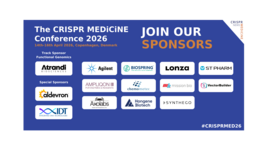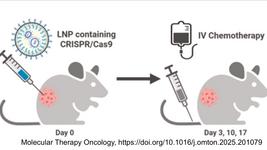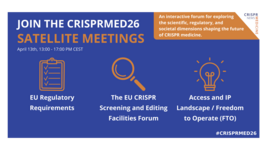CMN Weekly (7 February 2025) - Your Weekly CRISPR Medicine News
By: Gorm Palmgren - Feb. 7, 2025
Top picks
- Mice with two fathers have been raised to adulthood after Chinese scientists used CRISPR-Cas to modify 20 key imprinted loci in embryonic stem cells. These edits corrected imprinting defects that usually prevent unisexual reproduction in mammals. The team transferred 164 gene-edited embryos, but only seven live pups were born, and they didn't develop in an entirely normal way. They were bigger than untreated mice, appeared to have enlarged organs, a shorter lifespan, and were infertile. Regardless, the study demonstrates CRISPR-Cas’s potential for overcoming epigenetic barriers in cloning, stem cell therapy, and regenerative medicine
- An American study demonstrates that CRISPRa-modulated adipocytes suppress cancer growth by altering tumour metabolism, suggesting adipocyte modification as a potential metabolic cancer therapy. Upregulation of UCP1 in adipocytes increased glucose and fatty acid metabolism, reducing cancer proliferation in vitro and in xenograft models. Adipose organoids engineered to express UPP1 depleted uridine in the tumour microenvironment, suppressing pancreatic cancer growth.
Research
- NanoCas, an ultracompact CRISPR nuclease, enables efficient in vivo gene editing beyond liver-targeted therapies. Engineered from metagenomic data, it retains potent activity despite being one-third the size of conventional nucleases. In mouse and non-human primate models, NanoCas achieved >30% editing in muscle tissue, demonstrating the potential for single-AAV delivery in genetic therapies, including base and epigenetic editing.
- Two new, connected studies demonstrate that CRISPR-Cas9 editing of BCL11A +58 and +55 enhancers induces robust, long-term fetal haemoglobin (HbF) reactivation. Demirci et al. show durable HbF expression in rhesus macaques (>4 years) using antibody-drug conjugate conditioning. Zeng et al. reveal that editing quiescent haematopoietic stem/progenitor cells preserves engraftment while minimising genotoxicity. Together, these studies support safer, more effective gene editing strategies for β-haemoglobinopathy therapy.
- CRISPR-based cytosine base editing is expanded using FrCas9n, which recognises a unique NNTA PAM and enables a 6.3-fold broader editing range without context preference. High-fidelity mutations (R61A, Q964A) reduce off-target effects while maintaining efficiency. The optimised HF-ID824-evoCDA-FrCas9n editor is effective across multiple microbes, enhancing genetic engineering for functional studies and protein evolution.
- CRISPR-Cas9-engineered B cells show promise for protein-based biologics in genetic disorders, metabolic diseases, and cancer, according to a study by NIH and Be Biopharma. In non-human primates, adoptively transferred B cells expanded 10- to 15-fold, initiated IgG class switching, and homed to bone marrow, spleen, and liver post-infusion. PET/CT tracking confirmed stable distribution without adverse effects, supporting the feasibility of repeated infusions and the NHP model for B cell therapy development.
- An evolved AAV variant, Ark313, enables in vivo CRISPR-Cas9 gene editing in murine T-cells, achieving permanent genetic modifications in up to 25% of cells. Ark313 efficiently transduces naive and tissue-resident T-cells and delivers large DNA payloads. This method enhances tumour immunotherapy by editing T-cell genes to improve antitumour responses.
- CLEANSER, an open-source bioinformatic tool, improves accuracy in single-cell CRISPR perturb-seq screens by filtering ambient gRNAs that cause false-positive assignments. Using CRISPR barnyard assays, researchers characterised ambient gRNA noise and developed CLEANSER to distinguish native from contaminating gRNAs. The tool enhances gRNA-cell assignment precision and improves differential gene expression analysis.
Delivery
- Apoferritin nanocages loaded with Cas9/sgRNA ribonucleoproteins (RNP-) and doxorubicin (DOX) enable NLS-independent nuclear delivery of CRISPR-Cas9. DOX (1µM) triggers cellular defence mechanisms, facilitating nuclear translocation. Gene editing achieved 33% efficiency in MDA-MB-231 cells, 17.9% in Hela.copGFP cells, and 16% in vivo. This system offers a promising strategy for overcoming nuclear entry barriers in gene editing therapies.
- Lipid nanoparticle-delivered CRISPR RNAs enable in vivo immune checkpoint screening in glioblastoma, according to British scientists. Editing PD-L1 and CD47 in mesenchymal glioblastoma stem cells enhances immune infiltration and reduces tumour growth. This approach validates CD47 as a potential target and positions LNPs as a scalable tool for optimising immune checkpoint blockade in patient-derived models, advancing personalised glioblastoma immunotherapy.
- Focused ultrasound (FUS) can significantly improve the efficiency of CRISPR-based genome editing in the brain, according to a new study from the University of Texas Southwestern Medical Center. FUS transiently opens the blood-brain barrier (BBB) and allows adeno-associated virus (AAV)-mediated delivery of Cas9, leading to a substantial reduction in pathological glycogen accumulation in a mouse model of Lafora disease.
- A glutathione-sensitive dendrimer-Cas9 conjugate (D-Cas9) enables efficient, non-toxic CRISPR-Cas9 delivery. Using a hydroxyl PAMAM dendrimer and an inverse Diels-Alder click reaction, the system achieves near-complete GFP deletion in HEK293 cells and 20% VEGF editing in ARPE-19 cells. Rapid cellular uptake and stability suggest potential for scalable, cell-specific genome editing with reduced toxicity and immunogenicity.
Industry
- Vertex Pharmaceuticals has secured NHS England reimbursement for CASGEVY, its CRISPR-Cas9 gene-edited therapy for sickle cell disease, following NICE’s positive recommendation. This expands access beyond transfusion-dependent beta thalassaemia. CASGEVY, a one-time treatment, will be administered at specialised centres. Vertex continues to establish authorised treatment centres to ensure effective delivery.
- Arbor Biotechnologies’ CRISPR-Cas12i2-based therapy, ABO-101, has received FDA orphan drug and rare pediatric disease designations for primary hyperoxaluria type 1. The treatment uses lipid nanoparticle-delivered gene editing to disable HAO1, reducing oxalate overproduction. A Phase 1/2 trial will assess safety and efficacy. These designations provide regulatory incentives, reinforcing ABO-101’s potential as a first-in-class, durable treatment for PH1.
- 2seventy bio reports preliminary fourth quarter 2024 results with a net cash burn of $9 million and approximately $184 million in cash as of December 31, 2024.
Screening
- CRISPRi screening has identified NSD1 as a synthetic lethal target in SETD2-mutant cells. Suppressing NSD1, but not related methyltransferases, induces DNA damage and apoptosis, highlighting its unique role. Pharmacological inhibition using BT5 mimics this effect, demonstrating therapeutic potential. These findings offer a novel epigenetic strategy for targeting SETD2-deficient cancers, integrating genome-wide screening with genetic and pharmacologic modelling.
- CRISPR screening has identified PELO as a synthetic lethal target in cancers with 9p21.3 deletions or microsatellite instability-high (MSI-H) status. Loss of FOCAD or TTC37 destabilises the superkiller complex (SKIc), making PELO essential for ribosome rescue. PELO depletion triggers the unfolded protein response, highlighting its potential as a therapeutic target for these molecular cancer subtypes.
- A CRISPR interference screen in PDAC cells has identified RBM42 as a key regulator of MYC translation. RBM42 binds and remodels the MYC 5′ UTR, promoting translation initiation and co-regulating oncogenic transcripts like JUN and EGFR. Essential for Myc-dependent tumour growth, RBM42 represents a potential therapeutic target for disrupting oncogene expression in cancer.
- A CRISPRi-based method using truncated guides enables multi-locus screening of transcription factor binding sites. Guides with hundreds of matches effectively disrupt enhancer activity while maintaining repressive efficacy. Screening 13,000 CTCF sites, this approach directs H3K9me3 deposition and disrupts transcription factor binding, offering a scalable strategy for functional genomics and non-coding element characterisation.
- A CRISPR-based epigenetic screen identifies SMARCC2, a SWI/SNF complex component, as essential in enzalutamide-resistant prostate cancer. SMARCC2 and BRG1 chromatin occupancy expand in resistance, overlapping with CRPC-associated transcription factors. These findings highlight a regulatory role for SMARCC2 and suggest targeting the SWI/SNF complex as a potential strategy for overcoming enzalutamide resistance in late-stage prostate cancer.
Detection
- CRISPR-based diagnostics are simplified with a one-pot, room-temperature RPA-Cas12a assay using TsCas12a, an enzyme highly active at 25 °C. Unlike other Cas12a orthologs, TsCas12a enables sensitive HPV-16 detection in crude cervical swab samples. This approach eliminates complex sample processing and heating requirements, making CRISPR diagnostics more accessible for low-resource settings.
- A CRISPR-Cas13a-based photoelectrochemical biosensor enables ultrasensitive detection of circular RNAs in lung cancer patient blood. Using a Z-scheme T-COF/Ag₂S composite and Cu nanoclusters, the system achieves a 0.5 fM detection limit. Hybridisation chain reactions amplify the signal, while reusable magnetic beads reduce costs. This platform offers a promising tool for liquid biopsy-based lung cancer diagnosis.
- The DESCRIBER platform integrates recombinase-polymerase amplification (RPA) with CRISPR-Cas12a for sensitive, one-pot nucleic acid detection. A DNAzyme-triggered equilibrium transfer minimises interference, ensuring sequential activation of RPA and Cas12a. This method detects HIV-1 at 500 CPs/mL within an hour, demonstrating accuracy comparable to qRT-PCR.
- A portable CRISPR-based nucleic acid detection system enables self-testing for respiratory pathogens. Integrating extraction-free processing, RPA amplification, and CRISPR fluorescence detection, the microfluidic chip provides results within 30 minutes at a two copies/μL detection limit. A signal-light display simplifies interpretation, while freeze-dried reagents ensure stability. This user-friendly platform is ideal for home testing and resource-limited settings.
Reviews
- Nature Inspired Delivery Vehicles for CRISPR-Based Genome Editing. This review explores the innovative integration of CRISPR genome editors with various nanocarrier systems, focusing on recent advancements, applications, and future directions in therapeutic genome editing.
- Hereditary Transthyretin Amyloidosis Polyneuropathy. This review summarises current advances in the diagnosis and management of hereditary transthyretin amyloidosis (ATTRv) polyneuropathy, highlights challenges in early detection and treatment, and explores emerging therapeutic and diagnostic innovations, including CRISPR and artificial intelligence.
- Appraisal of CRISPR Technology as an Innovative Screening to Therapeutic Toolkit for Genetic Disorders. This review provides comprehensive insights into advances in the CRISPR diagnostics/therapeutics, which are believed to pave the way for reliable, effective, and low-cost genetic testing.
- Harnessing CRISPR technology for next-generation microphysiological systems. This review explores the integration of CRISPR-Cas gene editing into microphysiological systems (MPSs), highlighting their applications in disease modelling, drug discovery, and translational research while addressing current challenges, limitations, and future directions.
Perspectives
- A Technology Feature in Nature Methods describes how CRISPR-based RNA editing is advancing alongside endogenous ADAR enzymes, offering transient, precise transcriptome modifications with minimal off-target effects. New approaches, like PRECISE trans-splicing and ADAR-guided oligo editing, enhance RNA recoding without genomic alterations. As RNA-editing therapies progress, including trials for AAT deficiency, they may revolutionise treatments for neurodegenerative, autoimmune, and inflammatory diseases, positioning RNA editing as a key player in future precision medicine.
Webinars
- Today, Friday 7 February, CRISPR Medicine News will host a CMN Live session on LinkedIn with Alessia Cavazza from University College London. She will chat with our editor-in-chief over the topic "Prenatal gene editing for the treatment of early onset inherited diseases." It is free to attend, and the event goes live at 15:00-15:30 CET / 9:00-9:30 ET.
News from CRISPR Medicine News
- On Monday, we brought a write-up of a recent CMN Live session, where we spoke with Eligo Bioscience CEO Xavier Duportet about the human microbiome, its role in health and disease, and how gene editing within the microbiome could open a whole new chapter in medicine.
- On Thursday, our sister-site, WeDoCRISPR, posted a new content type, explainer carousels. The first in the series is an easy introduction to prime editing, the queen of the ball in the gene editing world. Try it out!
To get more CRISPR Medicine News delivered to your inbox, sign up to the free weekly CMN Newsletter here.
Tags
ArticleMissing linksNewsCMN Weekly2seventybioArbor BiotechnologiesVertex Pharmaceuticals, Inc.
CLINICAL TRIALS
IND Enabling
Phase I
Phase II
Phase III
Gastric Cancer and Colorectal Cancer, CRC, (NCT07166263)
Sponsors:
Base Therapeutics (Shanghai) Co., Ltd.
Sponsors:
Base Therapeutics (Shanghai) Co., Ltd.
IND Enabling
Phase I
Phase II
Phase III
Relapsed or Refractory Acute Myeloid Leukemia, AML, (NCT06541444)
Sponsors:
Base Therapeutics (Shanghai) Co., Ltd.
Sponsors:
Base Therapeutics (Shanghai) Co., Ltd.
IND Enabling
Phase I
Phase II
Phase III







